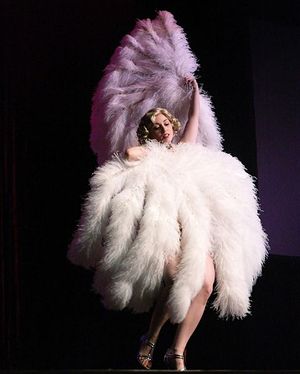Fan dance
A fan dance is a dance performed with one or more fans. This form has been adapted in various countries. The Korean fan dance, for example, evolved from Joseon Dynasty court dances and remains a popular form of traditional Korean dance. The Spanish or Portuguese flamenco makes dramatic use of fans. There also exists a form of fan dance in traditional Yu'pik culture in western Alaska; it bears little resemblance to the other forms represented herein.
In the West, a fan dance is often an erotic dance performance, traditionally by a woman. The performer, either entirely nude or apparently so, dances while moving two large fans, typically constructed from ostrich feathers. The essence of the choreography is suggestion, limiting the parts of the body exposed to the audience while focusing attention on illusions of exposure. Performers often evoke illusions of:
- having already seen what had never been exposed,
- not being able to shift one's gaze fast enough to see what seems surely to be presently exposed, or
- being aware of currently "seeing" what in fact is not exposed to be seen.
A fan dance can be viewed for erotic stimulation, aesthetic appreciation of grace and beauty, and for simple amazement of the skill of the illusion.
As of 2004, no fan dancer has been more famous than Sally Rand, who popularized it in the 1930s, remained the symbol of it throughout the middle of the 20th century, and continued to perform it beyond the age of 70.
In the UK, the fan dance has been used in the finals of the "Miss Nude UK" 2000 competition and in The Windmill Theatre in Soho where it replaced the tradition of nude tableaux and has since been replaced by table dancing. There have been claims that the latter has exclusive rights to it although it has also been seen at the Whitehall Theatre.
Fan Dancing's Evolution
In the 1960s, many gay men took great inspiration from the classic art of fan dancing, and created their own form of fan dancing, called alternatively fanning or fan spinning.
See also
Chat rooms • What links here • Copyright info • Contact information • Category:Root
